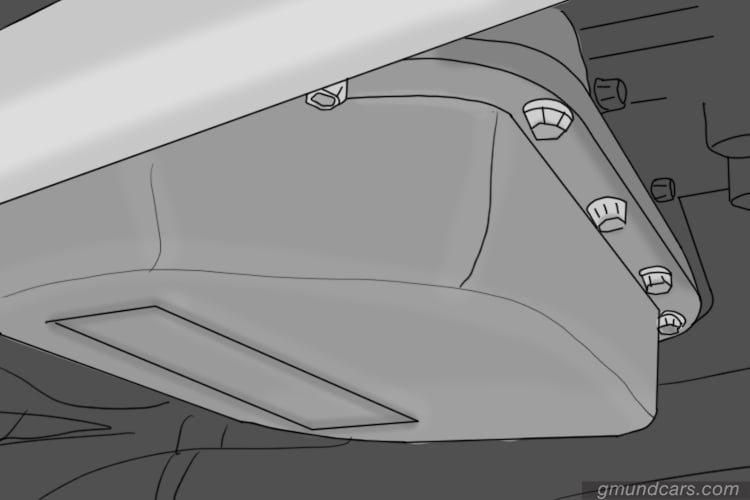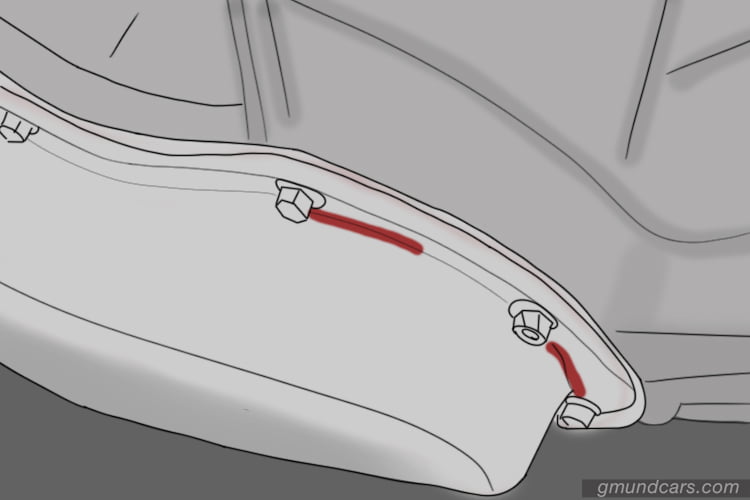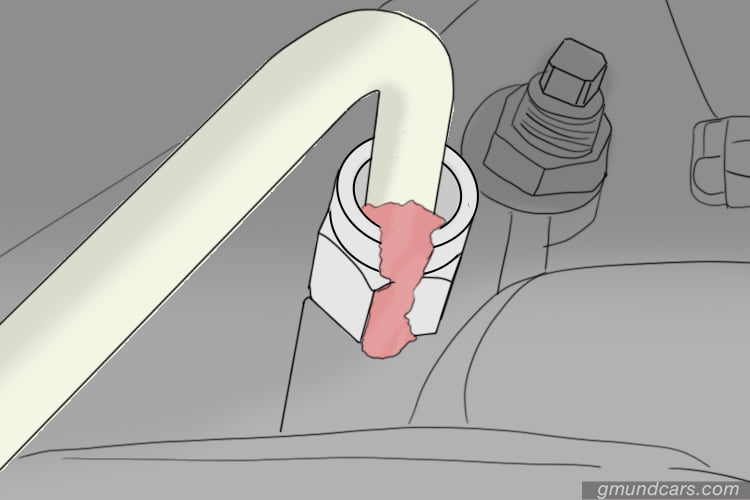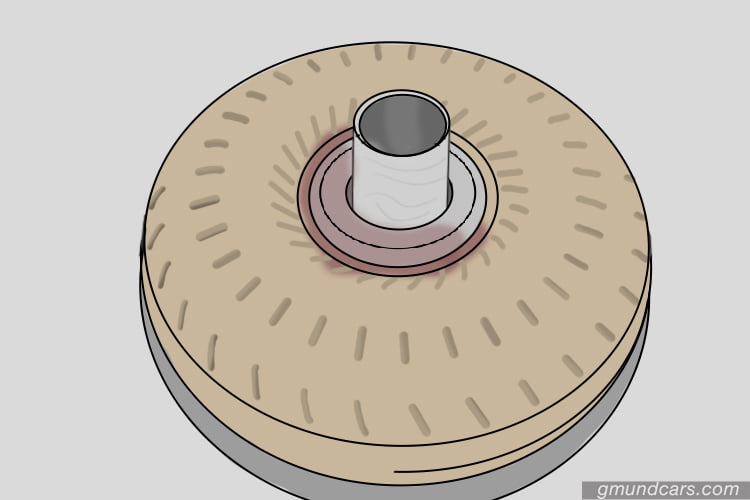Knock-knock, have you spotted a tiny pool of red liquid under your vehicle? This is a sign that your car’s transmission is leaking. You know what this implies? It can result in a significant amount of time, money, and hassle for you.
Oh no! don’t freak out. It is not the worst thing that can happen to a vehicle. You can deal with it easily if you know why the transmission is leaking and what you should do to fix it.
In this article, I will show you:
- How to identify a transmission leak
- Cause of transmission leak
- How to fix
- Other helpful information
Let’s get the ball rolling!
Symptoms of transmission fluid leak
Whenever you have to struggle with your vehicle’s gear, chances are your car has a transmission fluid leak. Don’t worry, it’s one of those minor issues you can deal with. However, for full confirmation, do watch for these signs.
Puddle underneath your car
Trust me when I point this as the easiest way to detect a transmission leak. Once you check beneath your car and notice dark spots on the ground, this should be your red flag. If I see this frequently along my driveway or garage, I don’t give it a second thought; I know it’s a leak.
For quick confirmation, get cardboard or white cloth and place it beneath your vehicle to catch leaky drops. Leave the car overnight. Double-check to make sure it is transmission fluid. If you see a brown, rusted-colored, or red color, then I’m sure it is transmission fluid.
Low transmission fluid level
If your car’s transmission oil keeps running low and requires constant top-up, it is a strong signal you shouldn’t ignore. You can check the fluid level by removing the dipstick if your car has one or check the electronic indicator for vehicles that do not have a stick. Every few days after filling the system with fluid, seeing your transmission oil level reach a minimum or below medium means the fluid is leaking.
Transmission issues
As a mechanic, I know how strange and stressful it feels whenever I have difficulty shifting my car gear. If it burns calories, I will be a supermodel. So, if your transmission bogs down, shifts roughly, or hunts, the fluid could be leaking. Even though these problems are not linked to leaky transmission alone, quick inspection is still recommended if you notice these signs.
Causes of transmission fluid leak
| Causes | Solutions | How to locate |
|---|---|---|
| Broken seals | - Use the transmission stop leak for minor leaks. - Install with a new one if the seal is heavily damaged. | You can find leaky seals commonly in the output shaft and input shaft. |
| Cracked fluid lines | - Replace the entire line can help you fix the problem. | Trace the fluid lines to check the transmission system. When you notice a part looking oilier than other parts, that’s a case of leaks. |
| Failure transmission pan/ Drain plug | - Use a wrench or plier to tighten the plug or bolts if they are loose. - If they are broken, replace them with new ones. | The pan is at the base of the transmission system underneath your vehicle, and the drain plug is at the center of the pan. |
| Fail transmission gasket | - Change the old gasket to a new one. | It is often made of rubber material and located between the transmission pan and your vehicle’s bell housing. |
| Torque converter | - Take your vehicle to shop service or dealership if you are not mechanic savvy. | Manual vehicles: It is located around the mechanical clutch Automatic vehicles: It is located between the engine’s flexplate and transmission container. |
If you are a curious person like me, you would want to know what causes a transmission leak. Take the backseat and enjoy the ride. As I unveil the potential causes of transmission fluid leak:
Broken seals
From my experience, a broken seal is commonplace for most vehicles, leading to transmission fluid leaks. This occurs when the seal deteriorates, wears out, and cracks, mostly due to frequent heat exposure.
You can find leaky seals in the output shaft located rear of the transmission extension housing. It is also situated in an input shaft connected to the engine through the clutch for manual vehicles or via the torque converter for automatic cars.
Failure transmission pan/ Drain plug
Debris and rocks on the road can cause the drain plug to loose and the pan to experience wear and tear while driving. Also, the drain plug can be faulty due to over tightening and bad installation. Over time, this damages your car’s transmission pan by creating a puncture and causing the fluid to leak.

The pan is at the base of the transmission system underneath your vehicle, and the drain plug is at the center of the pan.
Get a jack stand and lift your car from the ground. Look out for the transmission pan and touch around to detect the source of a leak. Use hand gloves in the process, so you don’t get your hands smoggy.
Fail transmission gasket
Wear and tear from constant exposure to temperature, a poor installation job, or manufacturing can cause the transmission gasket to crack. Damage like this can make the oil leak from your transmission.

It is often made of rubber material and located between the transmission pan and your vehicle’s bell housing. If you look through the transmission gasket and notice broken parts and cracks, these show a potential sign of leaks. Don’t hesitate to get a new replacement as it could breed more problems.
Cracked fluid lines
Transportation of transmission fluid is possible through fluid lines. You won’t expect them to come with cracks or faults since they are built from steel or aluminum with flexible hoses. However, long-term exposure to debris and heat can account for cracks/breaks.

Topline and bottom line that connect the radiator from below with the transmission. You can check the cooler lines (one of them connects the transmission system with the radiator). Trace these lines to check the transmission system. When you notice a part looking oilier than others, that’s a possible case of leaks.
Torque converter
The whole transmission fluid moves through your vehicle system with the aid of a torque converter. Anything from body crack to damaged needle bearings can cause transmission fluid to leak while propelling to action. Here’s a big pain; there’s no temporary or DIY fix to this. So, you need to consult a mechanic expert to fix this.

The location depends on the type of vehicle. It is located around the mechanical clutch for manual cars and between the engine’s flexplate and transmission container for an automatic transmission.
How to locate the leak using UV automotive leak detector kit
The best way to detect leaks faster is by using a UV automotive detector kit. It’s a death to any leaks in your car, and that goes for transmission fluid leaks. Here, you get a mini UV light, dye, and glasses in a package. It’s not rocket science!
- First, pour the dye on the suspected leak area or into the engine
- Run the engine for about 10 minutes and shut it off
- After turning off the engine, allow it to cool down and start reflecting the UV light on the spaces underneath your vehicle.
- Put on the glasses to get a clearer view of the thinnest leak hole in your car. (A glowing dye color will indicate the source of the leak).
Note: The dye is totally harmless to car’s engine, so don’t worry when using it.
How to fix transmission leak?
First considerations
What you can’t do yourself
- Your vehicle does not have a transmission dipstick
- Fix the torque converter
- Install new transmission seals
What you can do yourself
For other repairs, I am sure you can easily get the job done yourself by following this guide below:
Preparation
Before you get your hands dirty with this repair task, you may need to gather some necessary supplies and tools. They are:
- Screwdrivers
- Rags or towels
- Socket and wrench sets
- Ramps or jack stands, and jack
- Flashlight
- Funnel
- Cardboard
- Gloves
- Pliers
- Channel-locks
- Vise-grips
- New transmission fluid
- Drain pan
- Replacement parts like a new seal, pan, bolts, drain plug, and gasket
- Special pump machine (if your car does not have a transmission dipstick)
Step by step guide
Step 1: Drain the fluid
Raise the vehicle. No, no, no! Not with your hands! You are not the strongest man in the world! Use a jack and support it with jack stands to lift up your car. Then ensure you spread cardboard underneath your vehicle and put a catch pan because the task can be messy. There are two ways to go about this step. Remove the drain plug for vehicles that come with this feature. If your car does not have a drain plug, unbolt the transmission pan underneath to pour out the fluid.
Loosen the bolts at one side of the pan and ensure they are still attached. Remove the bolts at the other side and push the loosened side up so that the oil can flow freely and drain into the catch pan.
Step 2: Fix the problem
- Fix the broken seal
There is a formulation called transmission leak sealer that contains special additives. When you pour the transmission stop leak into the broken parts, it will penetrate cracks and form seal overtime to prevent oil from leaking through the broken seal.
- Fix the faulty drain plug/ pan bolts
When the drain plugs or pan bolts are loose or worn out, you can have a transmission leak. You can use a wrench or plier to tighten the plug or bolts. However, if you notice they are broken, replace them with new ones.
- Replace the pan
When the pan is faulty and causes the fluid to leak, you will need to replace it with a brand new one. Use a wrench to unscrew all pan bolts. Remove the pan from the transmission, replace it with the new one that you prepared before. Then tighten these bolts again, and you get the job done.
- Replace cracked lines
If your fluid lines crack, they can make the transmission oil leak. Replacing the entire line can help you fix the problem. Use a wrench to remove the nut that connects the line, then pull the old pipes to detach them from the transmission and radiator. Allow the oil to drain and remove dirt and grit. After this, connect the new lines to the appropriate spots and secure the nuts with a wrench.
- Change the pan gasket
Even though you can use a transmission leak sealer to prevent the oil from leaking due to a worn-out gasket, I recommend that you should change the old gasket to a new one. After taking the pan out of the transmission, using a gasket scraper to remove the gasket. Then attach the new one to the pan using oil-soluble grease. Finally, lift the pan into place.
Step 3: Refill with new fluid
If you have been able to fix the problems, you will need a new fluid to refill the transmission system. There are numerous fluid types, but you should ensure that you fill with the correct type of transmission oil for your vehicle. Remove the dipstick, place a funnel, pour the recommended amount of fluid into the system, and return the stick.
If your vehicle is not featured with a dipstick, use a pump that I mentioned earlier to refill new fluid via the drain plug into the transmission system.
Step 4: Check the dipstick again
After refilling the transmission system, start the engine to warm up, shift through all the gears to circulate the oil, and then shut it off. Open the hood, remove the dipstick, wipe it with a rag, reinsert it, take it out again, and check the oil level. If it is not reached the right level, add more oil but ensure you don’t overfill the transmission system.
Transmission leak repair costs
Here are some factors that affect the transmission leak repair cost: the labor cost, where the leak is coming from, the leak’s cause, and the severity of the damage. Besides, the sides that require repair also determines how much you will spend on transmission leak repair. For example, if a damaged front seal causes the leak, your expenses can increase because the mechanic must first take the transmission to get the problem fixed.
I recommend that you repair the leak yourself with simple issues as it helps save labor costs. Below is the comparison when you get the problem fixed by yourself and take your vehicle to shop service.
DIY
| Issues | Cost |
|---|---|
| Transmission drain plug/ pan bolts | $20 - $40 |
| Transmission pan | $30 - $90 |
| Transmission pan gasket | $10 - $40 |
| Cooler lines | $40 - $100 |
| Transmission stop leak | $10 - $50 |
Shop services comparison
| Cooler lines | Pan gasket | Transmission pan | |
|---|---|---|---|
| Your mechanic | $55-$192 | $109-$224 | $151-$380 |
| Mr. Tire | $68-$199 | $110-$245 | $149-$410 |
| NAPA | $61-$214 | $112-$230 | $165-$379 |
| Walmart | $15-$140 | $32-$120 | $66-$214 |
| Midas | $57-$204 | $118-$234 | $142-$399 |
Recall what I said, for replacing the new seal and fixing the broken torque converter, I suggest taking your car to shop service if you are not mechanical savvy. The cost to replace the seal will be around $400; fix the torque converter ranges from $600 – $1000.
Are you experiencing a severe problem with your transmission? I am sure this will happen to those who ignore the leakage problem for a time. In this situation, you need to replace the entire transmission system. Replace the clutch plates to the internal gears and other parts can cost a pretty penny: $2,000 and as high as $6,000 or more.
Final words
One of the most common transmission system problems is transmission fluid leak. I refused to accept this fact and prevent the problem when I was using my first vehicle. You know what? The only dry thing at the moment was my bank account. I spent a lot of money on my transmission repair to the extent that my pocket was screaming, and my stomach was hungry.
Don’t make the same mistake. Do regular maintenance, keep an eye on any leaky transmission symptoms, and fix the problem almost immediately to prevent a costly repair. You can correct the leaking issue yourself to reduce cost. Remember, I have breathed some mechanical skillsets into you, and it is time to take action.
FAQs
1. Can I drive with leaking transmission fluid?
It is not recommended to drive a vehicle with a leaky transmission although it is not really dangerous, especially if it is just a small leak. If you continue to drive the car without repairing the leak, the fluid level will drop over time drastically. This can later result in severe transmission system problems that can cost you a lot of money to repair or replace.
2. Will a car run without transmission fluid?
Likely, your car will not drive at all if your vehicle runs entirely out of transmission oil. The fluid provides coupling between your transmission and engine output, especially in automatic transmissions. So, if your car lacks oil in the transmission system, the process will not occur, and you won’t be able to start or move the vehicle.